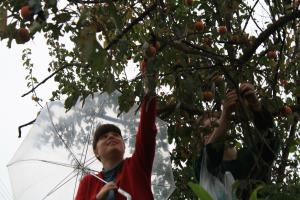The 2015 October Study Tour brought us to the Aizu area. I hear of Aizu most often as the coldest, most mountainous part of Fukushima, with beautiful sights and good food. We started off by going to two inspection buildings where foods and wild plants are tested to keep records of radiation levels and, most importantly, give proof that all foods sent to stores are safe to eat.
We then traveled to Tsuruga Castle, where we ate the famous sauce-covered pork cutlet and rice bowl, painted our own Akabeko (a famous cow character of Aizu), and traveled the castle. It was once a popular tourist and school trip destination, but since the 2011 disaster, visitor numbers have suffered greatly, and those working in the tourism industry have been hard at work trying to bring people back to enjoy the amazing sights in and around the castle and the Aizu area.
We broke into small groups and each spent the night and morning on farms. My farm family made a feast consisting of traditional Japanese fall foods such as sweet potato and spinach. The family grows cotton, so they let us attempt to deseed some raw cotton. It’s hard to believe how full of seeds it is! Deseeding is almost impossible to do by hand, but we tried our best to do so there was only one deseeding device. It was an amazing, relaxing time.
We moved on to our next destination, the Yamatogawa Sake Brewery and Aizu Electric Company. Since the 2011 disaster, many people have been hard at work to make Fukushima a trailblazer in renewable energy resources. Throughout Fukushima are all kinds of solar panels, with the purpose to one day make solar energy a more widespread power source.
In the afternoon we ate Oouchijuku soba, known for its quirk – it’s served with a stick of green onion as the utensil! Most people switch to regular old chopsticks after a few bites, though. Afterwards we made our own soba and traveled the shopping street, where we were met warmly by many of the local shopkeepers selling Aizu themed goodies.
We spent the night at the beautiful Higashiyama Onsen Shintaki, a combination onsen and hotel. Relaxing in the onsen made for an amazing night and morning. And I don’t know if I’ll ever spend the night at a hotel so nice ever again!
Next we traveled to Suehiro Sake Brewery, where we learned how sake is made. In simple terms, rice is mixed with a special mold and yeast, then pressed and drained into barrels. Doesn’t make sake sound very good, but for the taste of a good alcohol, I won’t think about it. We then walked Nanokamachi Street, where I painted an Aizu candle. There’s no erasing your mistakes, so it makes for a fun but stressful experience.
Our lunch was the famous Kitakata ramen I hear so much about from my co-workers. It was full of wanton strips in addition to more traditional ramen toppings such as green onion and meat.
After lunch, we traveled to Yanaizu Nishiyama Geothermal Power Plant, where we learned a little more about Fukushima’s recent focus on alternate energy sources. We finished off the tour with a trip to Yanaizu Enzoji Temple, a small but beautiful temple known as the Akabeko’s birthplace.
The scenic sights of Aizu in fall are just one of the reasons why I am happy to have gotten an English teaching job in Fukushima and nowhere else! If there’s one thing I want people to know about Fukushima, it’s a place where people are working hard to live and create pride in their home. 
|








